REMEMBERING DR. SREENIVASAN
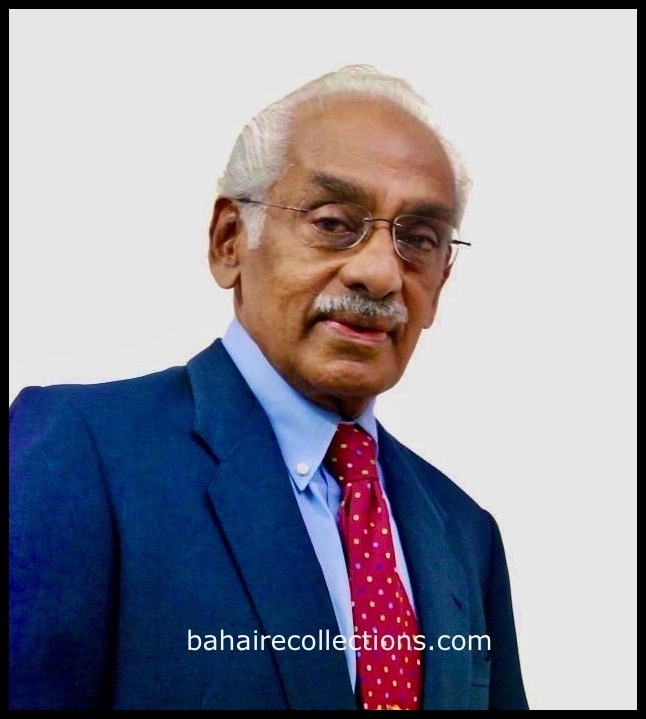
11 February 1931 to 23 July 2021
Dr. M. M. Sreenivasan affectionately called Dr. Sreeni moved as a colossal figure in the Malaysian Bahá’í community and served the Cause in various capacities with such an unprecedented driving force. Always on the lookout for how the Faith could be served, he ventured into areas less traveled and left no stone unturned to the best of his capacity.
Reading his life, there would be no convincing needed that from his childhood days he had been prepared for a great service that he was destined to play as he grew up. His parents were very conservative Hindus attending temple functions and practicing rituals at home. The parents encouraged him to attend temple rituals as well. Even when he was merely five years old, his parents had instilled religious values in him, which played a pivotal role in shaping his life and ultimately led him to accept the Faith of Bahá’u’lláh.
When he was 12 years old he came across some moving passages in the Bible that was left by a British Estate Manager. The statement in the Bible on heaven and hell sent fear into his spine and thereafter he decided never to be subject to punishment from God. He had his early education in Parit Buntar town, and after the Second World War was over, he resumed his education in the Penang Free School. A Reverend belonging to the Methodist denomination and a family friend of Dr. Sreeni’s parents offered him a room in his house in Dato Keramat Road in Penang. While Dr. Sreeni started to go to church every Sunday, he felt that there was something spiritually lacking that did not quench the fire of search in his heart. After prayerful days he left the Reverend’s house and stayed with the family of another lecturer. He also stopped going to church. Deep inside, there was an unquenchable spiritual thirst driving him to seek some light that suited his soul.
Upon completion of his Senior Cambridge Examination with distinction in the Penang Free School, he was sent to India where he obtained a medical degree from the Madras Medical College. During his student days in India, he continued reading many sacred books and asked for explanations from knowledgeable students. They have disunited themselves and seemed to be misinterpreting the Sacred Writings and that was acutely disturbing and confusing for him. His search for a living religion that has all its followers united was not to be found in India.

A young Dr. Sreeni
Just three months before graduating with a medical degree, his parents arrived in India and got him married to a girl they had chosen for him. He saw Miss Sulochana, Molly as came to be called later, for the first time on the day of their marriage! He would recall often that he was richly blessed with a wife who was truly an angel of God in every possible way!
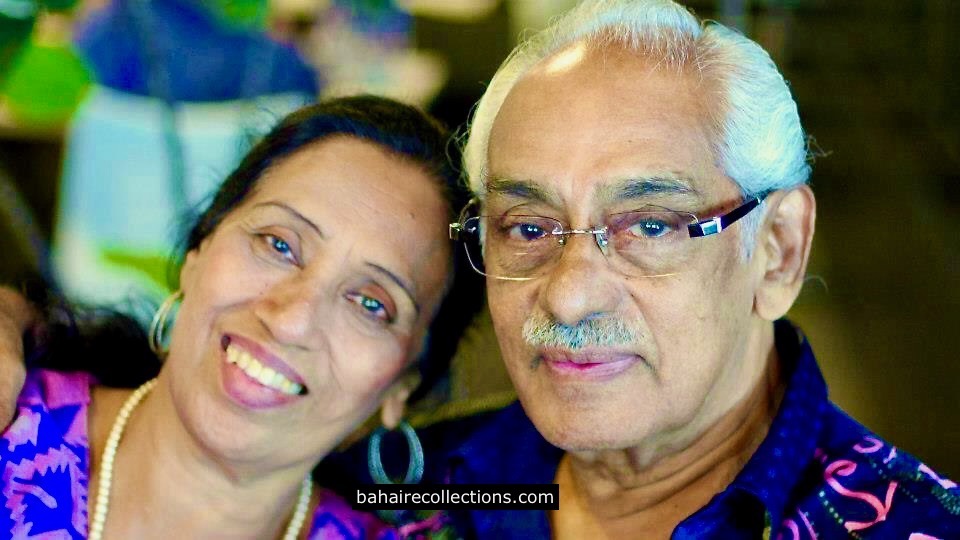
Molly and Dr. Sreeni led a life-long bond of love for each other and the Faith
Upon returning to Malaysia in 1960 with a medical degree, he joined the Government service as a Medical Officer and worked in hospitals in the towns of Taiping, Ipoh, Kuala Lipis, and a few other places. The moment he started his housemanship, he told his father to retire, after having sacrificed so much to get him and his siblings educated. He assured his father that he would look after him and his mother. All the while he was still deeply occupied in searching for a religion that suited his life, while still visiting temples, supporting Hindu rituals, and meeting Hindu spiritual gurus from India.
During this period, when his sister was going to be married, he applied for a fortnight’s leave. When his application was rejected with no consideration for family sentiments, he immediately tendered his resignation from the Government service.
He went back to Taiping where his parents were living and began a private medical practice. Soon his clinic became popular among the townsfolks. He was also invited to join several social service organizations. He established the Junior Chamber in an international organization and assisted the Rotarians, with the Taiping Town Council leasing a room for him to hold meetings. Temples in the surrounding areas too invited him to be at their functions. Heads of many government departments and non-governmental organizations became his very good friends. As a family, they were all happy.
While he was becoming a successful medical practitioner and well established in society, he and his wife became good friends with an Inspector of Police, Mr. Sivaraja who introduced them to Sivaraja’s wife, Ms. Padma. The Sivarajas arranged meetings in their home each Friday for one Mrs. Betty Fernandez from Bagan Serai town related to a new and different religion in Sivaraja’s home. Dr. Sreeni was not interested in yet one more religion.
While Dr. Sreeni had his own views, Divine Will played its role. A few days later, while Dr. Sreeni was in his clinic, an unknown local manager of the American International Insurance company by the name of Lim Chong Ghee handed over a book and said, “This book is from Mrs. Betty Fernandez, wife of our Officer in Charge of Police District in the Krian District. She conducts meetings every Friday in Inspector Sivarajah’s house. She asked me to hand over this book to you.” Dr. Sreeni guessed that it must be the work of the Sivarajahs to send Lim to present the book entitled “All Things Made New”. As soon as he flipped through a few pages, he closed the book when his eyes fell on some foreign-sounding names. He then shelved it with some other books on the table and forgot all about it. Out of the blues, his practice encountered an inexplicable difficult time, unbeknown to him that there was a power behind that, which he realized much later.
A few days later while he was sitting in his room in his clinic, Mr. Lim Chong Ghee visited him again. This time Dr. Sreeni felt relieved that he had someone whom he could converse with rather than worrying about difficulties confronting him! When Lim invited Dr. Sreeni to join his two other friends for lunch the next day, he instantly agreed. The next day Lim drove him to a nearby restaurant. At the restaurant, Dr. Sreeni was introduced to Mr. Ravichandran, an engineer from Kuala Lumpur, and Mr. Leong Ho Chiew, a Police Inspector working in Bluff Road, Kuala Lumpur and residing in Petaling Jaya. Before ordering the lunch, Leong suggested saying some prayers, and Ravichandran requested Dr. Sreeni to say a prayer and handed over to him a Bahá’í prayer book. Dr. Sreeni flipped through the pages and selected a short prayer which he read. It was the prayer for spiritual growth, “O God! Refresh and gladden my spirit…”. As he said the prayers he felt lighter and the burden weighing on his shoulders lifted! He felt a sense of joy that he had never experienced before. That was the first Bahá’í prayer that he recited. When he was informed that he had just read a Bahá’í prayer, he immediately asked for details of the Bahá’í Faith. Following a short introduction, Dr. Sreeni was enamored by the Faith and asked how he could become a Bahá’í. The excited Ravichandran gave him a Bahá’í declaration card to be filled. Dr. Sreeni signed the card without any further hesitation and became a believer. During lunch, there were detailed discussions on the Faith. Before departing for Kuala Lumpur, Ravichandran gave him a reel tape of a talk by Hand of the Cause of God Mr. William Sears delivered at the First Bahá’í World Congress in London in 1963, and also a copy of the book, “All Things Made New.”
That was the birth of a new Sreenivasan. A new chapter started in his life, which became a sweet beginning of a wide range of activities that enriched the history of the Faith in Malaysia. History would have it that the strange circumstances in which Dr. Sreeni came into the Faith and the great role he played since accepting the Faith was the direct working of Divine Providence.

S. Ravichandran at left and Leong Ho Chiew at right.
Returning to the clinic, Dr. Sreeni was more than convinced that the trials and tribulations which had befallen him for the past five years were to open his inner eyes. He meditated and it dawned upon him that those trials had their genesis in him ignoring the book All Things Made New! At home, he started reciting the Bahá’í prayers. It was his wife who first saw the transformation in him, followed by his mother. It did not take long before they too recognized and accepted the Bahá’í Faith.
The next few months were flooded with many unusual and happy events filling each day of his life. In November 1968, he moved to Butterworth town where he established his medical practice, his own clinic – The “Chaygin Clinic” at 4960, Jalan Bagan Jermal Road. With activities carried out by a handful of Bahá’ís in Butterworth, a few more accepted the Faith, leading to the election of a Local Spiritual Assembly was formed in 1969. Within the following two years, he was elected Chairman of the Local Spiritual Assembly of Butterworth. The Chaygin Clinic was used as a Bahá’í Centre which became a hive of activities. It was situated on the main road running from the northernmost town of Padang Besar to the southernmost town of Johor Baru. Believers traveling on that road started dropping in his clinic to meet up with him. His company simply uplifted the atmosphere.
In his own words, Dr. Sreeni was able to see the unfailing power of divine assistance in operation. Although he had lived in a rubber plantation settlement known as an estate in the pre-war period, he had not picked up the Tamil language, and even while studying for medicine in India, he had not taken up the language. The turning point was when he was thrown into “deep waters” in the Patani Para Estate near Sungei Petani town. On his maiden visit to the estate in 1970, Mr. S. Nagaratnam, a member of the National Spiritual Assembly who was also present there, requested him to say a few words in the Tamil language to the Tamil-speaking friends who were gathered there. The shocked Sreeni who was not fluent in Tamil, went for a walk alone in a dark alley, praying to be guided. When he returned to the gathering, he spoke what he thought was Tamil for some fifteen minutes. To his surprise, the friends who had gathered were appreciative of what he had shared. On another occasion, he conducted a Bahá’í wedding in the Tamil language at the National Bahá’í Centre in Kuala Lumpur. He also conducted a day-long spiritualization session in the Tamil language at the Tanjung Rambutan community in Perak. When sending off the first batch of travel teachers to participate in the South India Teaching Project at the Subang International Airport in October 1977, Dr. Sreeni spoke to them in very clear and moving words in the Tamil language. In the talk that lasted a full five minutes, he drove home the cardinal message that they were participating in a project of the Universal House of Justice, which is none other than the voice of God Himself for this day. He told them that they should feel proud to have been selected for such an immense project, and urged them to make Bahá’u’lláh, the Supreme Body, and the National Spiritual Assembly of Malaysia proud by bringing victories in the field. Many participants took his advice into their hearts and remembered those moving words in the teaching fields and even after returning home to Malaysia. Dr. Sreeni somehow had developed a love for the Tamil language. He recalled a time when he went all alone to meet with the priest and committee members of the Sunderaraj Perumal Temple in Klang where he gave a talk on Hinduism and the Bahá’í Faith. He recollected all these experiences and the words of Baha’u’llah “How can I succeed unless Thou assist me with the breath of the Holy Spirit, … and shower upon me Thy confirmations, which alone can change a gnat into an eagle…” Dr. Sreeni expressed that indeed he felt the powers of divine assistance and confirmation when he submitted and arose to serve even when he felt inadequate.
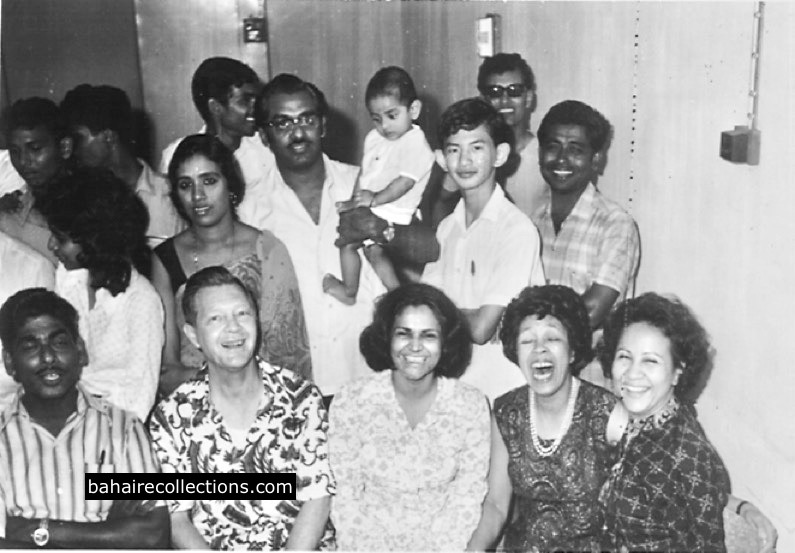
A gathering with David and Joy from Michigan, USA, in Butterworth, 1971. Seated L-R: S. Nagaratnam, David Earl, Betty, Joy Earl, Lily Janz. At the back-middle are Molly (L) and Dr. Sreeni (R) carrying Sha’in. At the extreme right at back is Vijayasegaran
In January 1971, Dr. Sreeni released the first issue of a monthly newsletter – “Light of The Age”, with the assistance of his nurse Teresa, and other youth in the community. That newsletter was well received with many news items and deepening materials, and many subscribed to it from across the country. The National Spiritual Assembly adopted it as Malaysia’s own monthly deepening bulletin and announced in the Malaysian Bahá’í News magazine’s December 1971 issue that the 12-15 page bulletin was unique in Malaysia, and perhaps the Bahá’í world. It was priced at M$1.00 for 12 issues and USD $1.00 for overseas. Free copies were made available to those who could not afford them. When Dr. Sreeni sent out the first few issues, Counselor Dr. Chellie Sundram himself, as well as many others were surprised by the resourcefulness of the monthly magazine and paid him a visit, to witness Dr. Sreeni typing out the newsletter with just two index fingers! When Dr. Sreeni moved to Kuala Lumpur in 1973, the magazine was renamed “Berita Bahai” which became a two-page circular with important news items from across the country. However, owing to other heavy commitments and the lack of resources the circular was discontinued, unfortunately.
Dr. Sreeni was fond of inviting visitors to Malaysia, whenever possible to meet the community in Butterworth. Towards the end of 1970, Mrs. Gibson, an American pioneer went across the country to encourage the Bahá’í friends to attend the forthcoming Oceanic Conference of the South China Seas to be held in Singapore in early January 1971. One of the places she visited was Butterworth, where she conducted deepening sessions using the recorded talk by Hand of the Cause of God on the theme of the majesty and greatness of the Local Spiritual Assembly. For this session, Dr. Sreeni invited some adults from the Bagan Serai town, who would benefit from these classes.
In October, the first Regional Youth Conference was organized in Butterworth where the National Bahá’í Youth Committee encouraged all to attend the Oceanic Conference to be held in January 1971 in Singapore. Through the efforts of Dr. Sreeni, a bungalow was booked for all to stay overnight. In declaring open the conference, Counsellor Dr. Chellie Sundram remarked that just one year ago, he would not have dreamt of such a conference in Butterworth and that it was Dr. Sreeni who was the driving force behind the youths who all rallied behind him to make it possible.
When a national teaching project was in progress, he rallied the members of the community in saying the Remover of Difficulties prayer 500 times, which was the first effort of its kind in Butterworth. Dr. Sreeni would be remembered for gathering together the older friends who had become inactive and ensuring that assistance was given to neighboring communities that needed assistance, such as Perai and Bukit Mertajam. The two activities that went on without fail were the weekly firesides and deepening sessions. The youths turned up in large numbers to listen to his deepening sessions. He was also a great motivator for the Inter-State Youth gatherings, bringing together youths from the states of Penang, and Kedah for a start in 1971, and gave every encouragement for them to be involved in teaching activities. Dr. Sreeni ensured there was always some attraction for the youths to frequent his clinic. He got hold of a carom board for the youths to spend their time when they were not involved in Bahá’í activities. Dr. Sreeni was the happiest when Hand of the Cause of God Mr. Featherstone visited many communities in the northern part of the country at a special venue in Butterworth in 1971.
From the moment Dr. Sreeni accepted the Faith he prayed that his thoughts, deeds, and words would reflect the teachings. He seized every opportunity to proclaim the Faith. When he and his wife were blessed with their fourth child, a son on 14 November 1971, they seized the opportunity and organized a naming ceremony for him in a public venue, in the presence of a large number of members of the public who heard of the Faith for the first time. Prayers were taken from the Tablet of `Abdu’l-Bahá as found in the Star of the West, Volume 9. That was an unprecedented effort in the history of the Faith. He had developed a very good relationship with the members of the print media which published news items on the Faith.
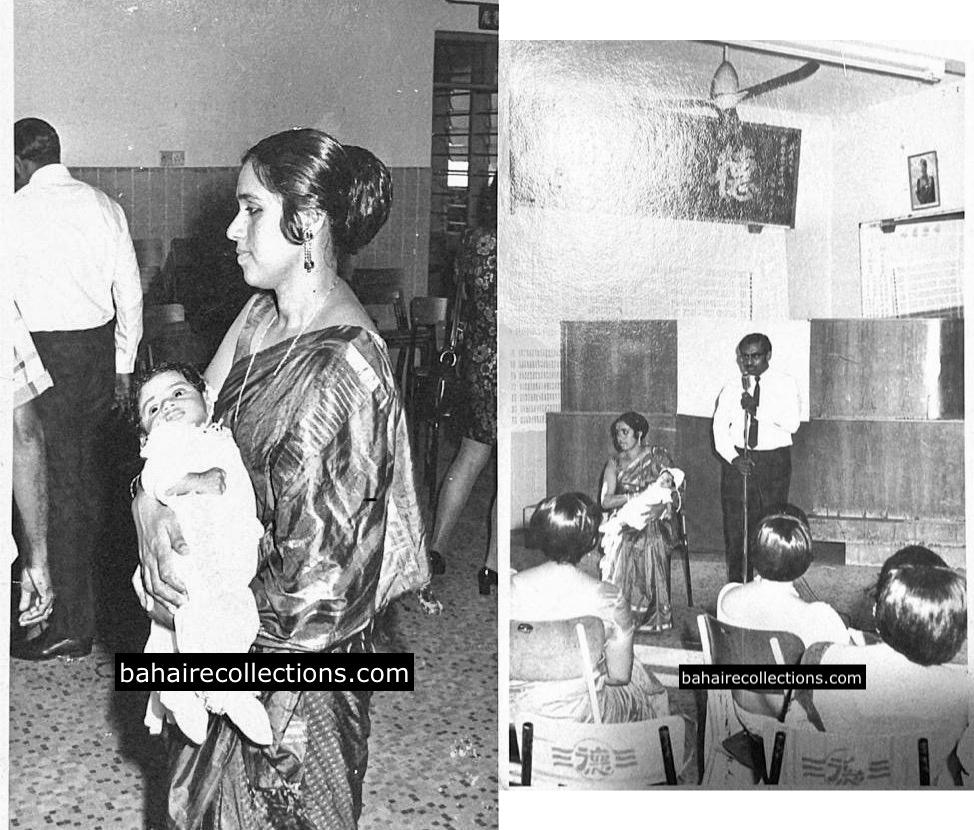
Naming ceremony for Sha’in
Mention has to be made that when Hand of the Cause of God Mr. Enoch Olinga came to the Oceanic Conference of the South China Seas held in Singapore in January 1971, as the official representative of the Universal House of Justice, the National Spiritual Assembly of Malaysia appointed Dr. Sreeni to be the officer in attendance for the Hand of the Cause. At the conference, Dr. Sreeni introduced himself to Mr. Olinga, who acknowledged him with his usual radiant smile. Dr. Sreeni was surprised and remarked that throughout those three days of the Conference, the Hand of the Cause did not request anything at all from him.
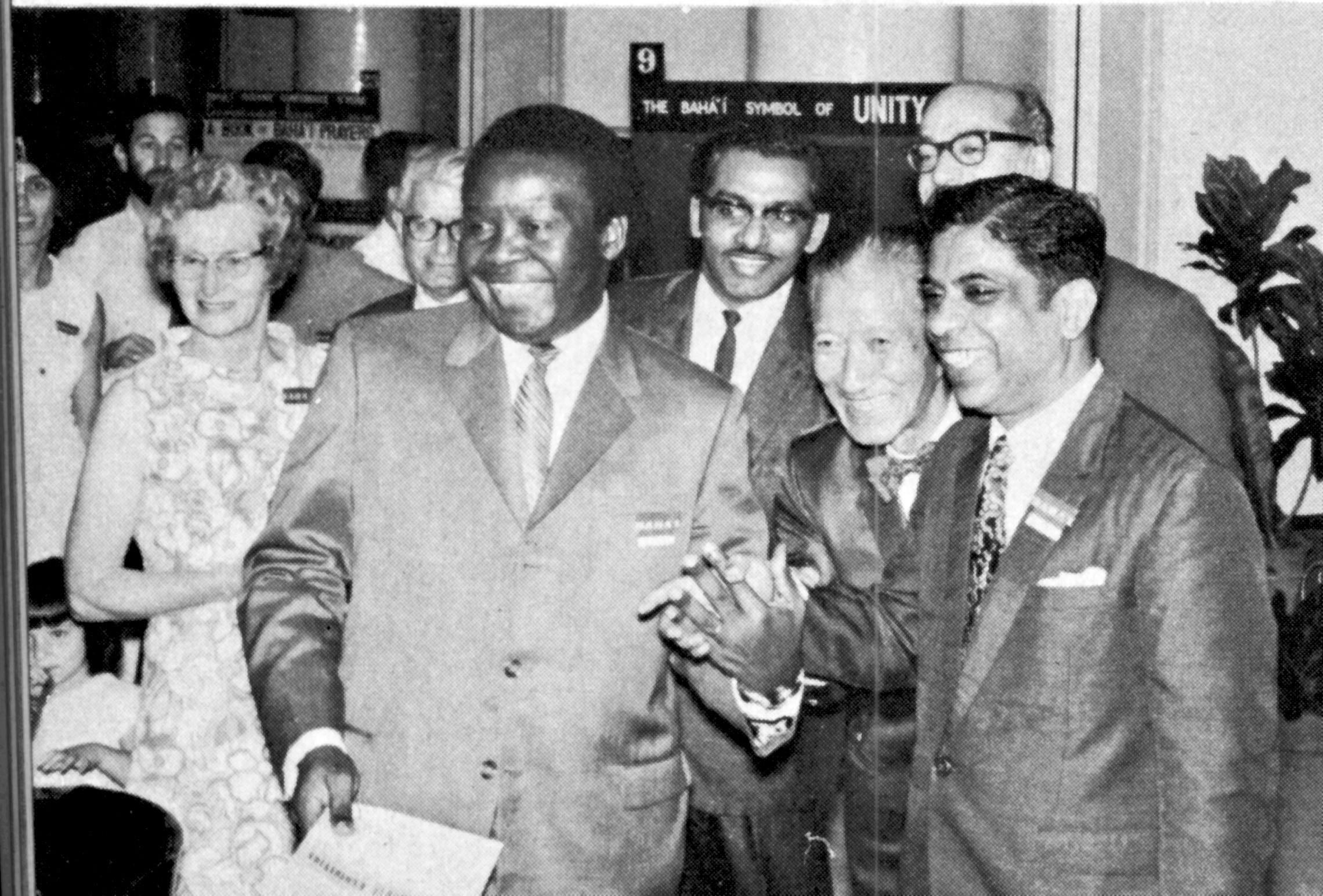
Exhibition at the Oceanic Conference in Singapore, January 1971. Front row L-R: Hand of the Cause of God Mr. Enoch Olinga, Dr. Sreeni, Yankee Leong, Dr. Chellie John Sundram, with Dr. Astani from Indonesia partly hidden at the back of Dr. Sundram. To the right of the Hand of the Cause is Mrs. Madge Featherstone
In Riḍván 1971, he was elected as a member of the National Spiritual Assembly of Malaysia and continued to keep the flame afire in Butterworth. But the turn of events forced him to relocate to Kuala Lumpur. In August 1972, Mr. Inbum Chinniah, Secretary of the National Spiritual Assembly left for Africa on a six-month travel teaching trip. Dr. Sreeni was then elected to serve as Secretary of the National Spiritual Assembly. With that, his family had to move to Kuala Lumpur first, and then into Petaling Jaya in the state of Selangor. That was a move undertaken following a period of an unprecedented surge of activities in Butterworth. His transfer was a great loss to Butterworth and a precious and tremendous gain to Kuala Lumpur and Petaling Jaya, and through which a new chapter began in his life, and by extension to the history of the Faith in this country.
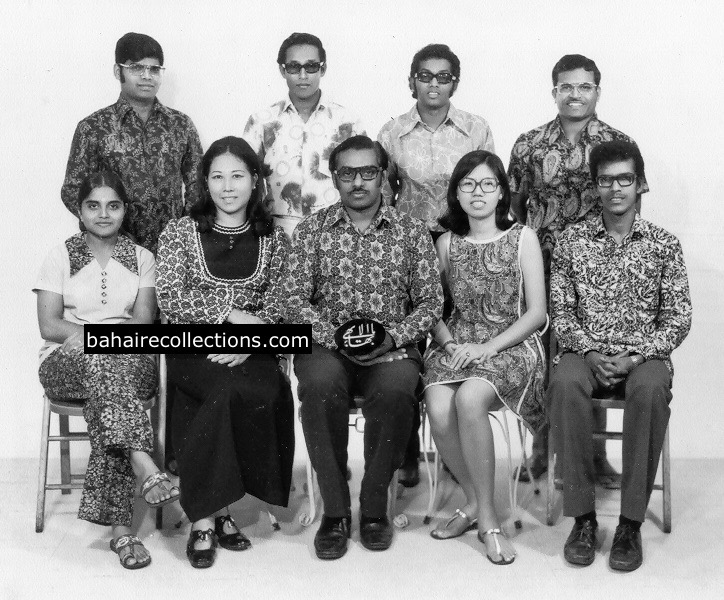
Local Spiritual Assembly of Kuala Lumpur, 1973. Standing L-R: A. P. Arumugam, Machamboo, Govindasamy and Jami Maniam. Seated L-R: Suguna Arumugam, Lily Chinniah, Dr. M. M. Sreenivasan, Yaw Kam Sim, C. Kanagaratnam.
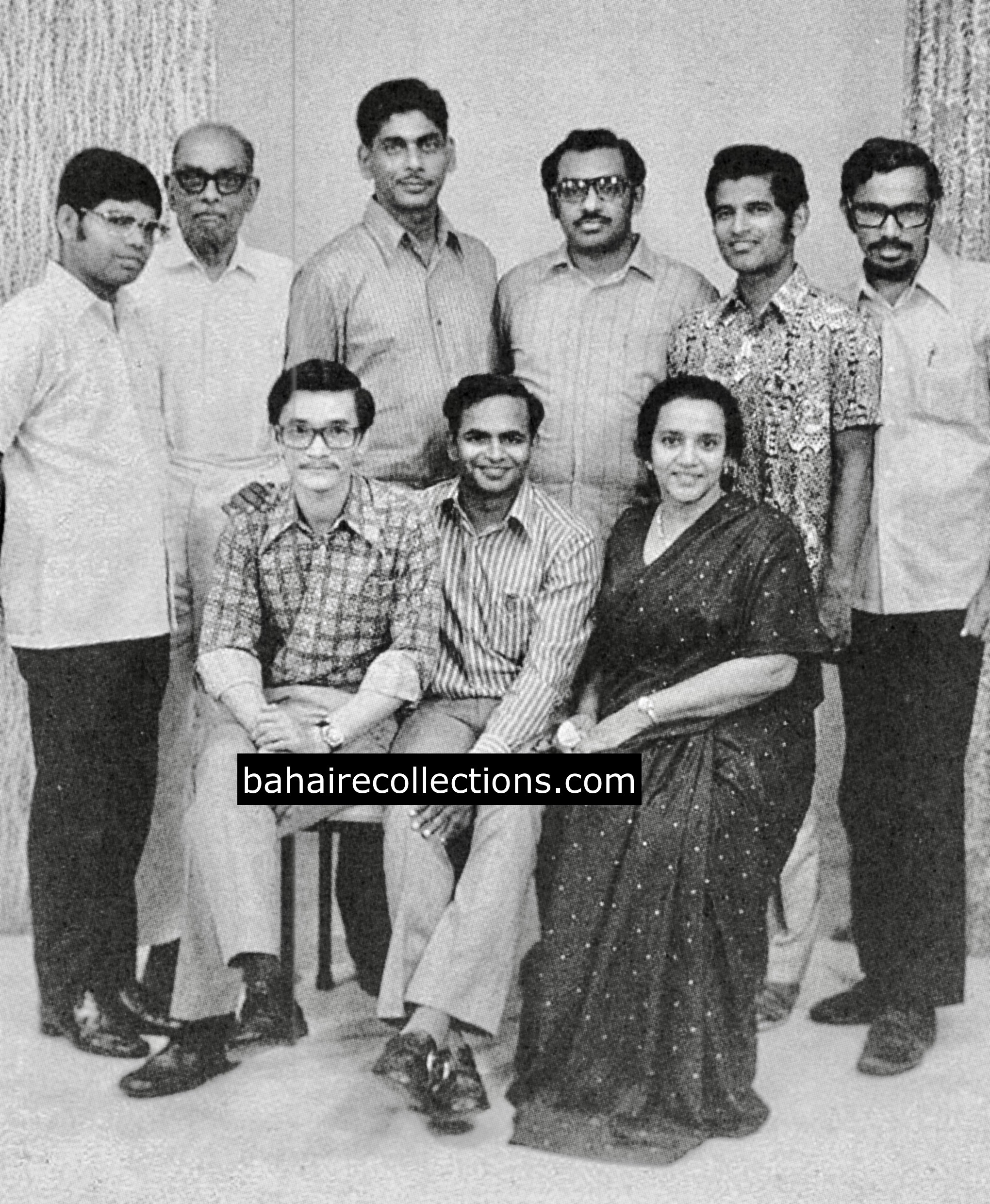 National Spiritual Assembly of Malaysia for 1973. Standing L-R: A. P Arumugam, K. Rajah, Nagaratnam, Dr.Sreenivasan, Isaac DCruz, and Dr. Singaraveloo. Seated L-R: Yin Hong Shuen, Ganasa Murthi and Shantha Sundram.
National Spiritual Assembly of Malaysia for 1973. Standing L-R: A. P Arumugam, K. Rajah, Nagaratnam, Dr.Sreenivasan, Isaac DCruz, and Dr. Singaraveloo. Seated L-R: Yin Hong Shuen, Ganasa Murthi and Shantha Sundram.
He was already a lover of the Writings and following the Spiritualization Institute held in Port Dickson in December 1972 with Jenabe Caldwell coordinating it, Dr. Sreeni continued to be actively involved in Weekend Spiritualization Institutes in several parts of the country.
He was appointed to the Pioneer Committee in 1973 and continued to be involved in all community activities while shouldering the heavy responsibility of discharging the duties as Secretary of the National Spiritual Assembly. In 1974, he was appointed Assistant to the Auxiliary Board member, and in 1976 he was appointed as an Auxiliary Board member. Over the years he had also served in various capacities, including as Assistant Registrar of Marriages in the 1980s. He served with unabated ardor and carried out his duties as unrestrained as the wind across the country while still based in the Petaling Jaya community. He walked into yet a few more paths less traveled. He began traveling to many parts of Malaysia for teaching and deepening and at the same time meeting with visitors from overseas, including the Hands of the Cause of God.
As an Auxiliary Board member, Dr. Sreeni became an excellent communicator. He initiated a weekly newsletter called “From the Desk of Dr. Sreeni” that was sent across the country, carrying a lot of deepening materials, messages from the institutions, and news items. The recipients were very thrilled to receive them. That became a newsletter that was much looked forward to.
Always eager and ever ready to do something for the Cause, he ventured into a number of less traveled or never traveled paths. In 1977, he initiated for the first time a new kind of teaching campaign- the Nine-Day Teaching Campaign in the upcoming Subang Jaya residential area. He was able to pool the resources from the central part of the country with daily phone calls to individuals. The Faith was well proclaimed to the neighboring places and on its success, this kind of teaching campaign was emulated in several other parts of the country.
He initiated the State-Level Women’s conferences across the country starting with Malacca state in 1977. He also organised similar States state-level conferences in the states of Perak, Kedah, Selangor, Pahang, and Negeri Sembilan. A large pool of women arose to serve the Cause in various capacities after the conferences. The Bahá’í World Centre was accordingly informed of these laudable efforts.
Yet one more new area of teaching that he initiated was the Family Teaching projects. He would organize firesides for families and in most cases, entire families enrolled into the Faith. And in all these campaigns or projects received the full support and blessings from the Local Spiritual Assemblies concerned. Dr. Sreeni was also actively involved in teaching projects held in other parts of the country. On a number of occasions, he had also adopted some new communities and given all the support needed until they could stand on their own feet. Estate communities were not neglected. On a number of occasions, Dr. Sreenivasan had obtained the permission of the estate management to organize firesides in the community halls, with attendance to capacity. One such was the Midlands Estate near Kuala Lumpur. To ensure the teaching went well he took along some believers who were fluent in the Tamil language to give support services, like Maheswaran and Mrs. S. L. Thevar.
Dr. Sreeni had the uncanny talent of detecting which were the new communities that needed much assistance. One such was the Tanjung Malim community that was dormant from the early days of the Cause. Here the family of Mr. and Mrs. Narasiah, fairly new to the Faith, needed assistance in the late 1970s when they became key believers. Dr. Sreeni made weekly visits to deepen them and give talks at firesides organized by the family. It did not take long before the community was on fire. One other community that held a special place in his heart was the Klang Bahá’í Community. He would visit this nascent community every week with other friends till a flourishing community was established there.
It was a great surprise to many that Dr. Sreeni was very much technology savvy, learning and excelling in new technologies. And this was one talent that he displayed till his very last days, adjusting, and adapting to changing times and changing technology. He was generous in sharing the arrival of new knowledge of the Faith with other communities. He was one of the very earliest to possess a slide projector as early as 1970 with which he projected colorful slides of the Holy places in the Holy Land in some other countries. The viewers who saw them for the first time were greeted with astonishment and amazement by those magical slides. He was one who had the largest collection of talks delivered by prominent visitors to the country and at Conferences, including talks delivered by the Hands of the Cause. Much of these recordings were given to the Bahá’í Publishing Trust in Malaysia.
In 1977, he initiated for the first time the dubbing of the film strips of the Holy Land into the Tamil language, especially for the Tamil speaking believers, who were quite deprived of such materials in their native language at that time. He tapped the talent of Mrs. Narasiah and the author to provide the voiceover for the film strips. He himself went through the translation of the text and made the needed amendments, where needed. The first of the series was on Pilgrimage to the House of the Báb, followed by several others, which all went very well with the Tamil-speaking friends. When the first official recording of Bahá’í songs in the Tamil language was undertaken by the National Teaching Committee in 1982, Dr. Sreenivasan provided assistance in getting them recorded at the Petaling Jaya Bahá’í Centre and had them edited and passed on to the national institution for further action.
When the travels of Amatu’l-Bahá Rúhíyyih Khánum to the Amazon jungles were filmed, under the title of The Green Light Expedition, a copy was made available to the National Spiritual Assembly of Malaysia in 1976. Dr. Sreeni got hold of a projector and screened it in many parts of the country, starting with the Petaling Jaya Bahá’í Centre. He screened the same in the Seremban Bahá’í Centre and in the community hall of the Escot Estate near the Tanjung Malim town, to name a few.
Yet one other area where Dr. Sreeni put in much effort was getting families to organize weekly deepening classes at their homes, an effort he initiated in 1984. He himself worked with coordinators from other communities and posted deepening materials to those coordinators. He came up with a curriculum that covered many vital topics of the Faith. This project too went well with the communities.
He introduced a new way of learning messages from the Supreme Body. For each passage, he would insert a question for which the said paragraph itself would come as an answer. That was a novelty by itself by which the participants learned not only quicker but deeper as well. Whenever he started a deepening class, he would pass around empty pieces of papers on which the participants would write out all the questions and doubts they had without the need to write their names on those papers. He would answer those questions at the first meeting to the extent needed. Those questions that were raised would form the basis for him to gauge their knowledge on the subject and decide on the depth of the deepening materials he had to prepare for the classes to follow.
There was yet one more area of his service that astonished everyone in the community. He proved to be a very good organizer of events, leaving as far as possible no loopholes. It was at the Summer School of 1972 held in Penang that Dr. Sreeni played the role of Principal. He ensured every aspect was well organized. Thereafter, having moved into Petaling Jaya, the national institution, taking cognizance of his organizational excellence, tasked him to be principal of several Summer Schools and conferences of large scale. He made it a point to drive to the venue a few days in advance with a checklist and ensured every aspect was well in place. And he was generous in training others to follow suit. In organizing such events of great magnitude Dr. Sreeni ensured he took along other believers who would assume the role of Vice-Principal. To him, no work was half-finished. He used to tell the believers, “When the whole world looks at the horizon, we Bahá’ís should learn to look beyond the horizon.”
Another inspiring quality of Dr. Sreeni was the voluntary spirit he had within him. And with that voluntary spirit he was among the first to respond so much so that the national institution, national committees, and several individuals felt that if there was one person on whom they could count on for important work for the Cause, Dr. Sreeni became a natural choice. Whenever there was work to be done for the Cause, he would contact the institutions and ask if he too could contribute to some role, however small or big it may be. Dr. Sreeni was always in the mainstream of activities. The one other area where Dr. Sreeni took great responsibility was in receiving visitors from the airport and sending them to the hotel or accommodating them in his own house, and naturally taking them around the country to meet communities. He was always about the first to arrive for community functions. His most liked part of Bahá’í life was the fasting period. He would wake up earlier than many others and ring up members of the community wishing them happy fasting. He would start first with the youths staying in the Bahá’í Centre. The alarm of the clock may fail to ring, but not the calls from Dr. Sreeni!
Dr. Sreeni was a natural, prolific, and gifted speaker at events of all magnitudes, including Summer Schools, and commemoration of United Nations jointly organized by the community. And the element of stage fear was never in his system. He would take to the floor and address with no prior preparation. And he could move the hearts of the listeners, with choice of the right words and phrases, not leaving out appropriate passages from the Writings.
Dr. Sreeni speaks at the Conference of Board members and their Assistants with Counsellor Shantha Sundram held in September 1988 in the NUBE building, Port Dickson
Dr. Sreeni and his talents were well recognized in the wider world as well. He had developed great relationships with many prominent figures in the higher echelon of society, and was well-known in many Non-Government Organizations, including the Pure Life Society in Kuala Lumpur. The Inter-Faith Spiritual Fellowship (INSaF) was yet one more organization into which the National Spiritual Assembly of Malaysia appointed Dr. Sreeni to represent the Faith. In that organization membered by some 35 different organizations, Dr. Sreeni promoted the Faith by presenting papers at several of its functions.
All his days he was computer savvy and took up teaching the Faith through the internet. Following a talk entitled “Journey of the Soul” that he delivered at the Pure Life Society on 17 June 2006, there were several calls requesting him to set up a website to expand further on that title. That gave birth to the setting up of a blog spot entitled “Journey of the Soul”. He also hosted “The Spiritual Highway site on Facebook. After prayerful meditation, Dr. Sreeni would post passages from the Sacred Scriptures, which would serve as a guide to seekers around the world. The core of his daily messages was, among others, the purpose of creation of every human being, preparing ourselves before our souls leave this human dimension, and endeavoring to get glimpses of the life after. Upon posting the messages, he would spend time answering inquiries from across the globe. He also set up one more website entitled LIGHT OF UNITY in which he wrote articles on the Bahá’í concept of Heaven and Hell. On all his websites he left his telephone contacts and email address, along with his home address for enquirers to contact. And surprisingly many were in constant communication with him seeking clarifications on what he had written. In January 2011, he went on to publish an 89-page e-book, entitled: You Will Not Die: From a Missing Link in Today’s Educational Format. In later years Dr. Sreeni was also making every attempt to get UNICEF to publish a book along the same lines until his health situation slowed him down. History will read that Dr. Sreeni alone has undertaken such a massive and major effort in spreading the Cause through the internet media.
He would wake up at 5:00 in the morning and pray, after which he would send out Bahá’í passages to all the contacts in his WhatsApp, and again reach various parts of the globe. That was an outstanding service that no others had carried out with such zeal and commitment. He was consistent in these two efforts until the year 2018 when he slowed down following a mild heart attack. Even when his health was failing at the end of his days, he attempted to practice what his parents had taught him from his childhood, and which he stepped up after accepting the Faith- to be prayerful all his days. Even when he was not able to stand still or bend down, he, after showering at dawn, forced himself to say the Long Obligatory prayer in privacy, which had difficult actions that followed for an ailing person. As his ailing condition did not enable him to continue the genuflections related to the Long Obligatory Prayer, he had to reluctantly give up.
He always looked for ways and means to serve the Cause in a wide range of services. He had an unmatched driving force. He traveled extensively to support Bahá’í activities in other communities, never turning down invitations received at the last moment. He was a very close confidant of Hand of the Cause of God Dr. Rahmatu’lláh Muhájir and lover of the elders in the Faith. If asked what he would consider as blessings that he would always cherish in his heart, his reply was the blessing to have met in person Hands of the Cause of God Dr. Muhájir, Mr. Abu’l-Qásim Faizí, Mr. Collis Featherstone, and Mr. Enoch Olinga. Among the many believers whom he loved very much were Mrs. Shirin Fozdar, “Spiritual Mother” of Southeast Asia, Mr. Yankee Leong, the first believer of Malaya, and Inbum Chinniah, the much-loved Counselor. Dr. Sreeni had the painting of Mr. Yankee Leong’s house in his home. Most of all he was always a strong supporter of the Institutions of the Faith and a defender of the Covenant of Bahá’u’lláh.
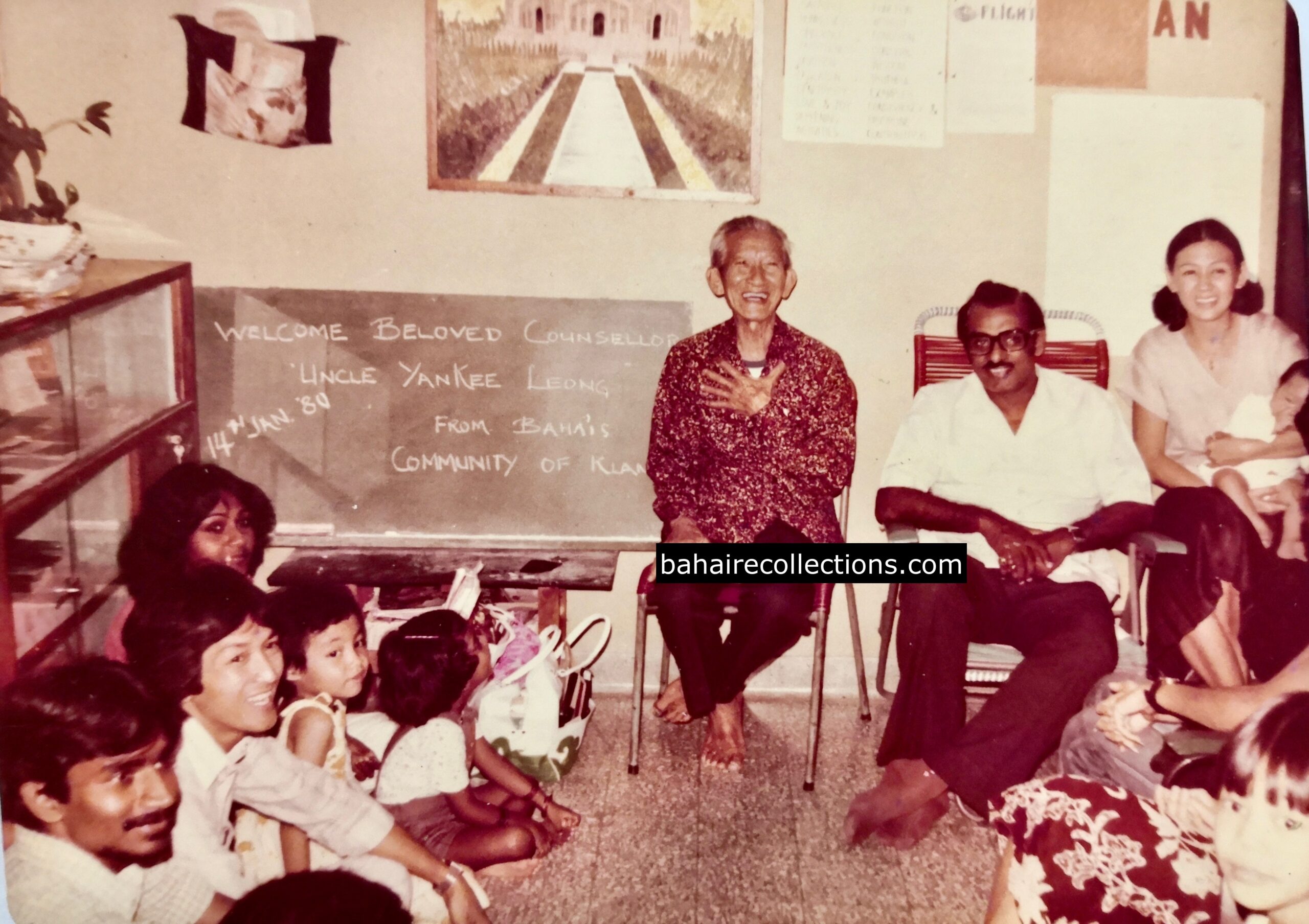
Visiting the Klang community in 1980 in the company of Yankee Leong, seated to the right of Dr. Sreeni
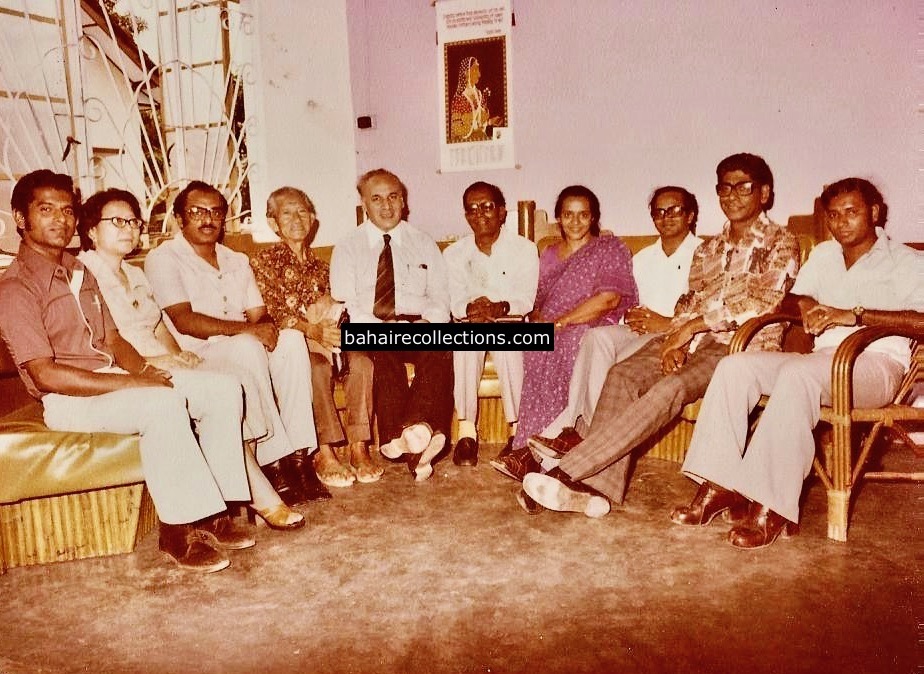
Meeting of members of the Spiritual Assembly of the Bahá’ís of Malaysia and Auxiliary Board Members with Hand of the Cause of God Dr. Muhájir at the National Bahá’í Centre, Kuala Lumpur, 1978. L-R: Isaac D’Cruz, Theresa Chee, Dr. Sreenivasan, Counselor Yankee Leong, Dr. Muhájir, Inbum Chinniah, Shantha Sundram, R. Ganasa Murthi, S. Nagaratnam, S.Balasekaran

With Hand of the Cause of God Mr. A. Q. Faizi at the South East Asia Bahá’í Regional Conference, Port Dickson, 1976.
For the sake of the Cause, Dr. Sreeni was fully aware that one had to sacrifice much. He had many talents and interests and among these was painting. He had a natural talent for art, producing beautiful oil paintings in his younger days. Naturally a creative individual, he brought this quality of creativity into all areas of endeavor, foremost in his service to the Cause. He never allowed attachment to personal interests to detract him from attending to what was the urgent need of the times. He consecrated his time, energy, and creativity to the betterment of his fellow man through his joyous and tireless service to the Cause.
His zeal in serving went beyond imagination. He would always be on the lookout for believers with hidden talents and tap those talents to the maximum. He had lovingly urged university students to organize public talks on the Bahá’í Faith at residential hostels. One such grand talk was at the PP Narayanan Hostel in 1977, receiving good publicity for the Faith. When he noticed that some friends were influential in society, he would urge them to organize gatherings in their homes for deepening sessions. A medical doctor he was, and he also led many believers to find spiritual solutions to their physical healing, tests and difficulties. When believers approached him with their personal difficulties, he not only consoled them using the Writings but would urge them to involve themselves in greater levels of service to the Cause.
Dr. Sreeni could also be said to be an ambassador for the Faith in that he promoted the Cause in the widest way possible through his wide circle of contacts locally, nationally and internationally. Having moved into the state of Selangor, Dr. Sreeni started to work in the clinic owned by an insurance firm. That was the MCIS clinic, located at the Jaya Puri Hotel, later named Petaling Jaya Hilton. He held the position of National President of the MCIS clinics in the country. The clinic had visits by very prominent customers of the prestigious hotel for treatment. And his clinic was a self-teaching center, with displays of Bahá’í quotations and photos on the wall. Those prominent patients either acknowledged the presence of Bahá’ís in their respective countries or enquired about the Faith. And he also had several prominent local people coming to see him for consultation, and that included Cabinet Ministers. He used all these contacts to promote and where needed to protect the Faith. Dr. Sreeni was able to get several Bahá’í youths employed in eminent positions with just phone calls. He was also able to get pending cases of citizenship through his influence. When the national institution formed a task force to distribute the Promise of World Peace Message from the Supreme Body in 1986, Dr. Sreeni became a natural choice to sit on that committee together with a few other believers who moved in the higher echelon of society, including Colonel Dr. G. Gopinath. Dr. Sreeni was able to provide a good number of good contacts for distributing the statement.
There was one other great assistance that Dr. Sreeni was able to render the Cause. With the managerial staff of the Jaya Puri Hotel visiting him for treatment in his clinic he was able to get the conference rooms in the hotel at extremely low rates. That enabled organizing national conventions, large-scale gatherings for talks, and even weddings at that hotel.
As far as possible, his thoughts, deeds, and words were always attuned to the tenets of the Faith. When Jami Subramaniam of Kajang Community wanted to pass over his car registration number of BAB 1844, Dr. Sreeni gladly took over and fixed it on his Toyota Corona Mark Two model car. The registration number itself was a sight to behold for both the local believers and visitors from abroad who traveled in the car. That car had hit all the roads in Malaysia and visited some of the remotest parts as well. In 1981, when Dr. Sreeni was driving to treat a patient, the car met with a major accident and was totally written off. Dr. Sreeni sustained serious injuries and was hospitalized for a month. Several friends visited him in the hospital and the entire Malaysian Bahá’í community in Malaysia prayed for his speedy recovery. As soon as he was discharged from the hospital he wrote an article in the Malaysia Bahá’í Bulletin entitled “Before You Were Born”, on how God prepares one for coming into the world, and the role of spiritual education by parents after birth. For a long time, Dr. Sreeni was moving with the aid of a walking stick. Yet his indefatigable spirit never waned, and he continued to serve with full force, much to the astonishment of the community.
Despite moving like a meteor in various parts of the country and being involved in various activities at the same time, it is a wonder that he found time for the family. He took good care of the family as a good husband and a great father. He and his beloved wife created a Bahá’í atmosphere at home. He installed a big single tile on the wall of their home with the following passage from a prayer in bold red:
O my God! I ask Thee, by Thy most glorious Name, to aid me in that which will cause the affairs of Thy servants to prosper, and Thy cities to flourish. Thou, indeed, hast power over all things! – Bahá’u’lláh
At home, Dr. Sreeni held table talks over dinner on Bahá’í subjects. Not a week passed without any gathering at his home. Whenever visitors came to Malaysia, more than anyone else he would organize gatherings in his house to meet the community. His beloved wife Molly was exposed to the Faith through Dr. Sreeni, Betty, and through the deepening classes held in the Chaygin Clinic, and was touched by the teachings on progressive revelation, and accepted the Faith in 1971. Molly was the essence of loving hospitality and created an atmosphere of love and comfort for all during these occasions. He also took along family members during his visits away from home while serving whenever possible.
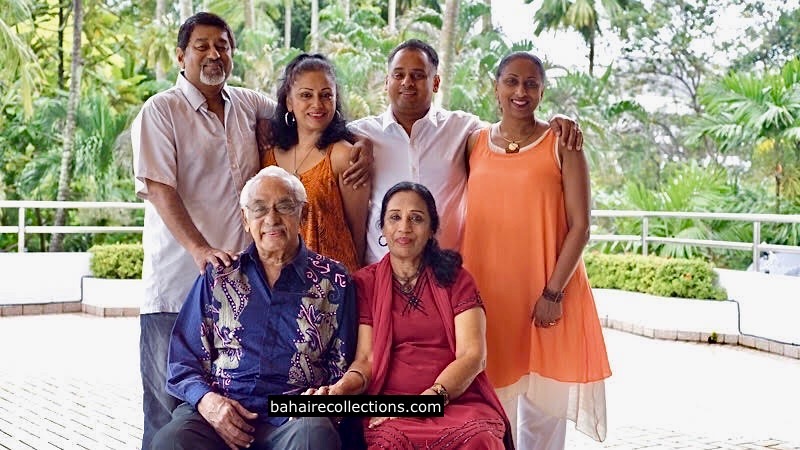
With their four children, L-R: Raj, Omna, Sha’in, and Asha
And he was a proud father of four children who married spouses of different races – he practiced what he believed. And his love and concern were for all in the community. He cared for the welfare of one and all in the community. Whenever he learned of someone in distress, he would visit the person constantly, and pray until the problems afflicting the person were solved. The pain and sufferings of others became his own burden as well. Thus, he not only believed but also practiced the cardinal teaching of the Faith on becoming one soul in different bodies.
Among the many Bahá’í activities which he was engaged in, the one that was his driving force and greatest passion was his devotion to teaching the Cause, and that he did till his last breath. He was happiest when getting news of teaching activities, and sad to the core of his heart when the activities slowed down. Even while recuperating at the hospital, he was involved in giving the message to the staff there. One would wonder what was the secret of Dr. Sreeni always teaching the Faith, under all situations. Herein lies the passage by that was that propelling force in him, as he would always quote“Where there is love, nothing is too much trouble and there is always time.”
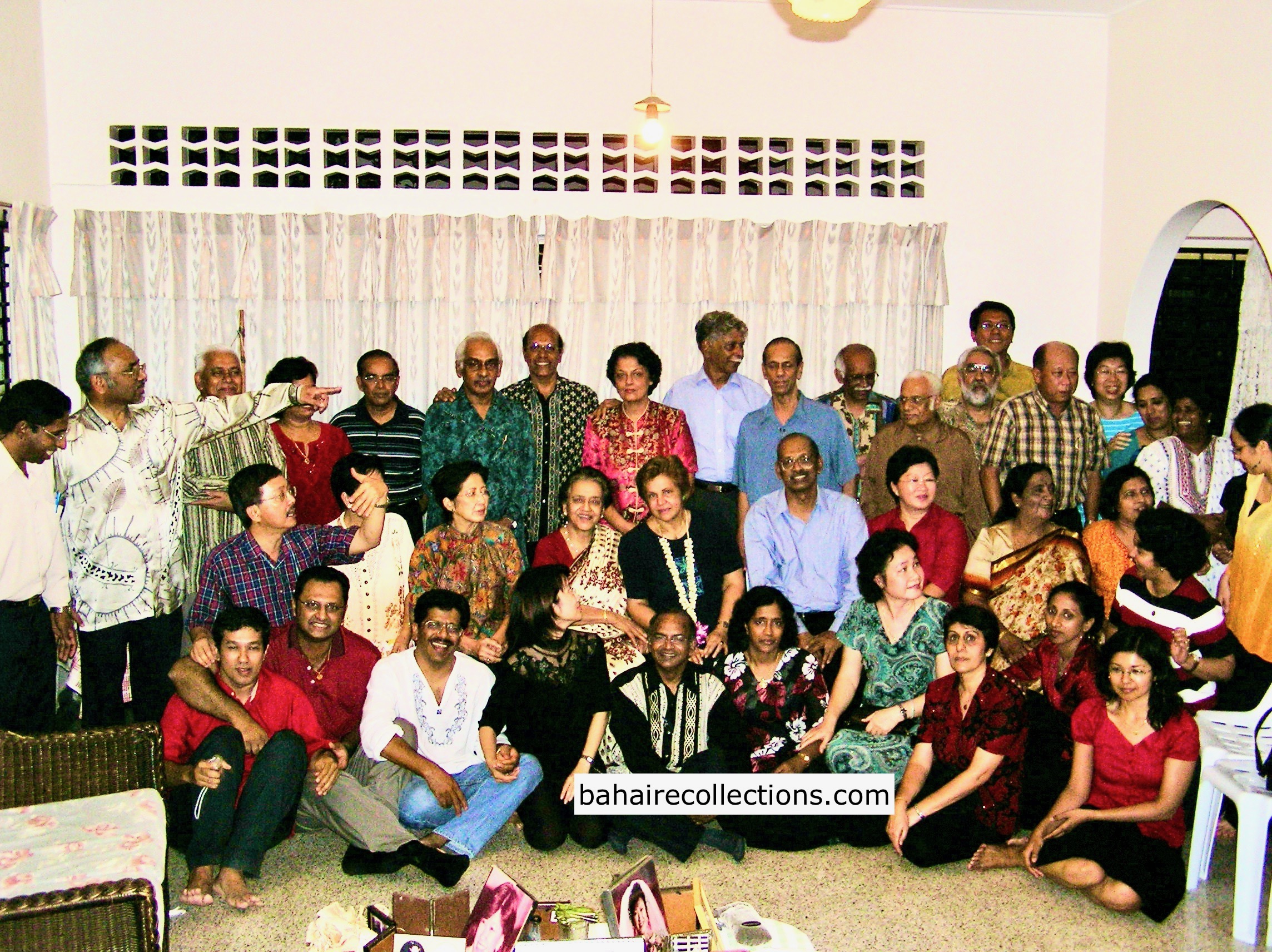
Dr. Sreeni, standing sixth from left, never missed the company of devoted workers for the Cause. He is at the gathering held in honour of the visit by Mrs. Shantha Sundram and Mrs. Betty Benson in 2004
Throughout his Bahá’í life, Dr. Sreeni was not heard of backbiting on any person- believer or member from the community of interest alike. Whenever he felt there was an issue, he would take the issue to the national institution and rest the matter at that level. He was very much admired and appreciated as an honest person in organizations where he worked until the end of his life. In his own effective way, he brought in many sympathizers and well-wishers for the Cause.
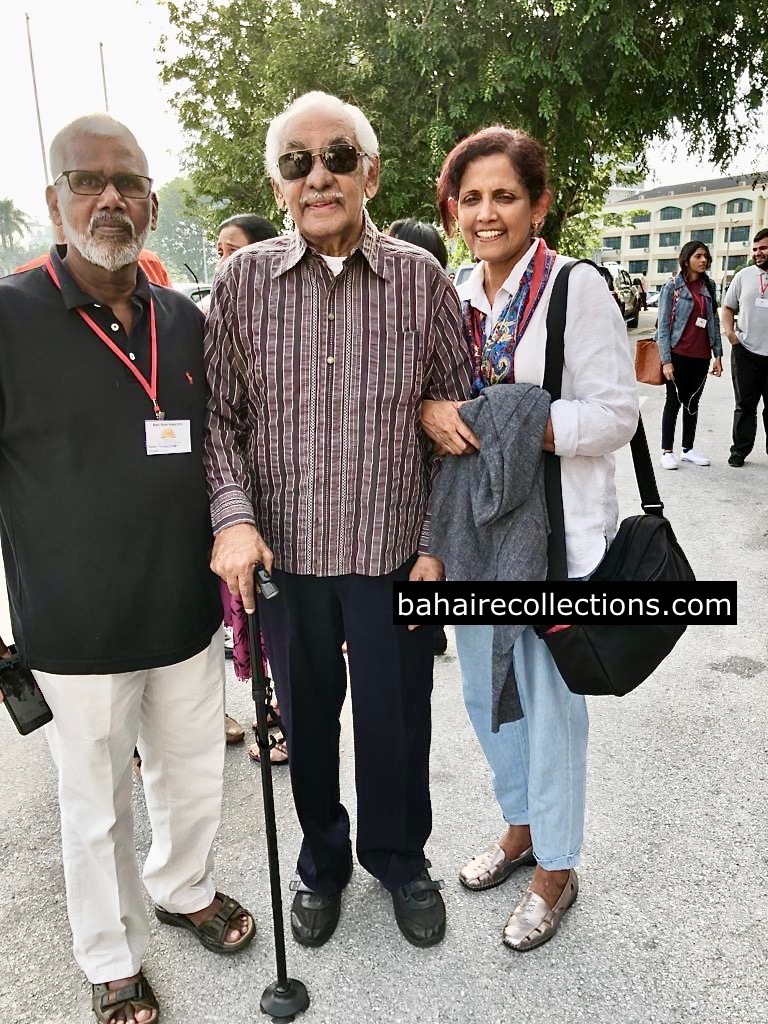
With A. Ponnusamy (L) and Usha Cheryan from Melbourne (R) at the Bahá’í Summer School held in 2018, the last major event of Dr. Sreeni.
His precious soul winged its flight into the realms on high at age 90, having served the Cause relentlessly, and with such a driving force seldom seen in others of his time and his age. He was a spiritual father to many individuals and several communities. With his passing, he leaves the inspiration of his life of services in the hearts of many people who knew him. For all the loving services and sacrifices he had rendered with so much energy and zeal we can be assured that Dr. Sreeni is in the loving arms of Bahá’u’lláh in the next world.
You may leave your comments at: info@bahairecollections.com
A. Manisegaran
28 February 2022
Copyright@bahairecollections.com